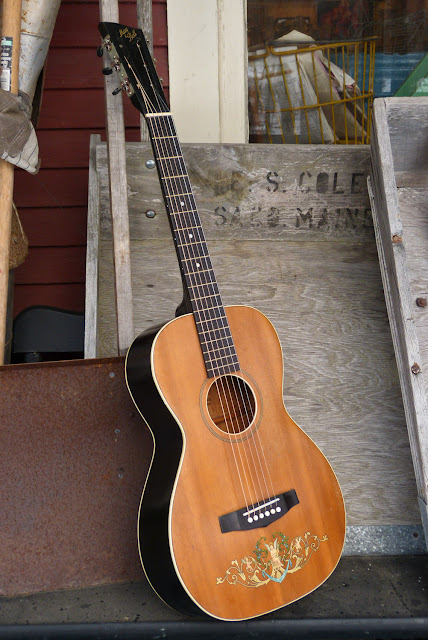1930s Regal-made Slingerland MayBell Parlor Guitar
Among old-time players, these old Regal-made MayBells keep getting more and more popular. I suppose it has to do with the warmer, sweeter sound of the transverse ladder bracing on them compared to "regular" ladder bracing and the fact that they're relatively plentiful in the market. The unintended Maybell Carter tie-in on the headstock might help, too!
I've worked on a lot of Regals of this same general make and this one is a little more gussied-up with a fancy decal on the lower bout and binding on the back and top, but the body is the usual spruce-over-birch deal and the neck is poplar with a stained-maple fretboard -- standard-issue. It's like a non-sunburst, slightly-less-fancy version of the #7 model of the time. It has a woody, open sound and, after work, plays great with 1/16" DGBE and 3/32" EA action, at the 12th fret, strung with 50w-11 strings.
I did this one up for a customer and it needed a new bridge, fret level/dress, side dots, a new saddle, and a good setup. Some other work had been done in the past and the neck angle was ok, so I left all that alone.
The only cracks on the guitar are on the back and a longish hairline in the fretboard (which tend to dry out like mad).
The bone nut is a wide 1 7/8" and appears to be old, if not original. The tuners, interestingly, are the same type used on Gibson/Kalamazoo products from the same time. I'm used to seeing the simple "flat plate" types on these.
The brass frets still have decent height after the fret level/dress job. I added side dots per the customer's request.
The instrument has a short, 24" scale length -- which is within 1/8" of what Harmony and Kay were also mostly using for their "standard sized" guitars -- with 13" lower bouts like this one.
The new bridge is a black-stained rosewood one with a Kay/Stromberg-Voisinet-style pointed "belly." It looks authentic enough for the period but has a drop-in, compensated saddle slot and a bit more grab on the guitar's top for increased stability.
The decal is clean, isn't it?
The back and sides (birch) are stained black, as well as the neck.
There was a somewhat-lame black plastic strap button on here which I replaced with this older-looking, Gibson-style button.



















Comments